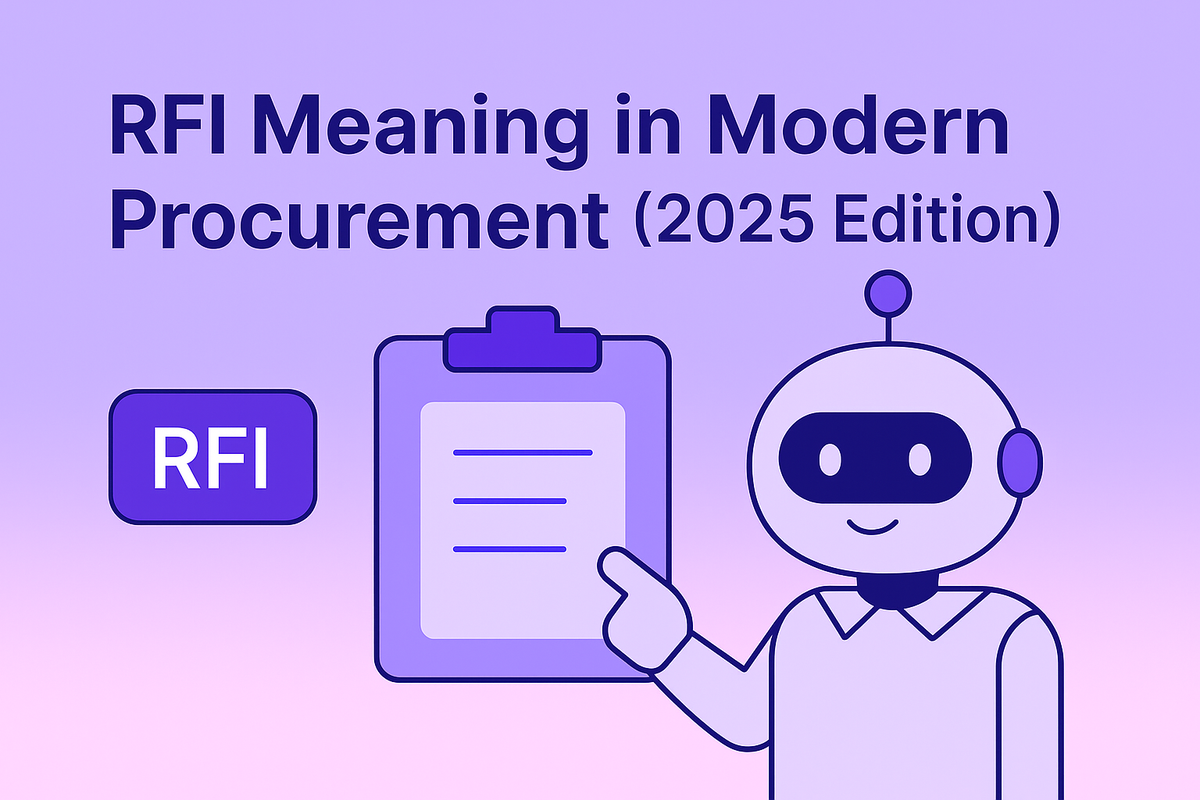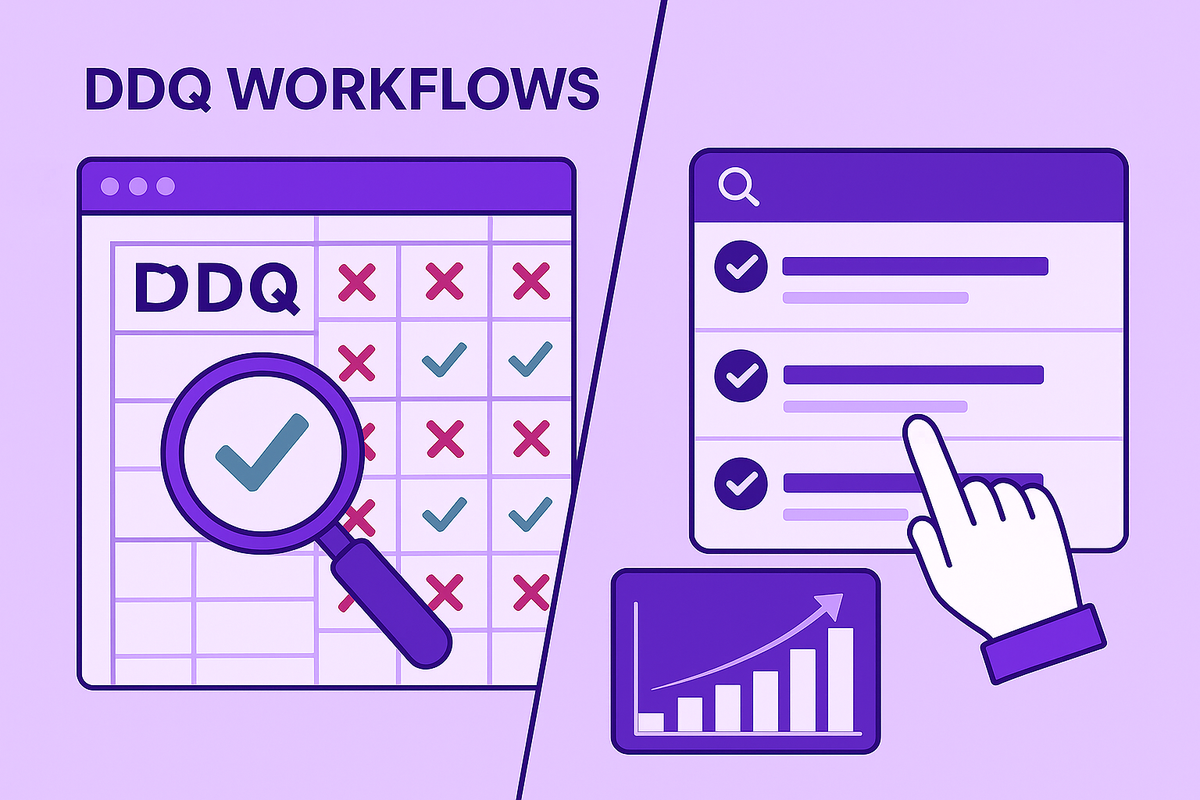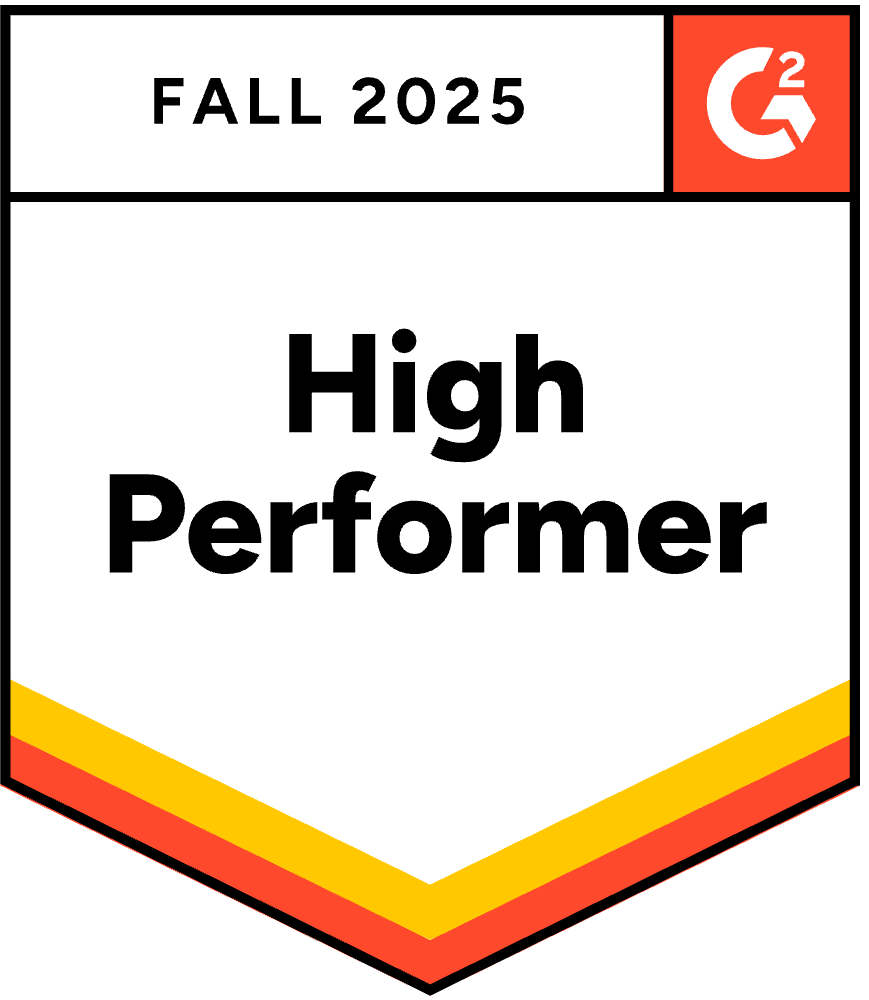How to Automate Vendor Security Questionnaires
November 10, 2025
By
Evie Secilmis

Does your team spend more time answering security questions than talking to customers? Are you constantly worried that an outdated answer from an old spreadsheet might derail a promising deal? When a new Vendor Security Questionnaire comes in, does it feel more like a crisis than a routine part of the sales process? If you answered yes to any of these, you're not alone. The manual approach to VSQs is broken, leading to burnout, errors, and stalled deals. The solution isn't to work harder; it's to work smarter. This guide will show you how to automate vendor security questionnaires, transforming a painful process into a streamlined, efficient workflow.
Key Takeaways
- View security questionnaires as a trust-building exercise: Instead of seeing them as a sales roadblock, treat VSQs as your first opportunity to prove you're a reliable partner. A quick, thorough, and professional response can set you apart from competitors and accelerate the deal cycle.
- A single source of truth is your most powerful tool: The real value of automation comes from a centralized and up-to-date knowledge library. This is the foundation for eliminating inconsistencies, reducing human error, and ensuring every response is accurate and approved.
- Pair automation with human oversight for the best results: An effective VSQ process isn't about replacing your team; it's about empowering them. Use AI to handle the heavy lifting of generating first drafts, but always have a clear review and approval workflow to ensure final answers are perfect.
What Are Vendor Security Questionnaires (and Why Do They Matter)?
If you’re in sales, you’ve probably seen them—long, detailed forms that land in your inbox, asking about your company's security practices. These are Vendor Security Questionnaires, or VSQs. Think of them as a due diligence deep-dive. Before a company brings on a new partner or vendor (that’s you!), they need to understand and manage any potential risks.
VSQs are their way of asking, "Can we trust you with our data and our business?" They are structured tools used to evaluate the security, compliance, and operational maturity of any third-party your potential client relies on. These questionnaires dig into everything from your data encryption methods and access controls to your incident response plans and employee security training. While they can feel like a roadblock in the sales cycle, a strong, fast response can actually build a ton of trust and set you apart from the competition. It shows you’re a professional, secure partner who takes their responsibilities seriously. Answering them well isn't just about checking a box; it's a critical part of the sales process that proves your value and reliability. Getting this step right can be the difference between closing a deal and getting stuck in a lengthy security review.
How VSQs Manage Risk
At its core, a VSQ is all about risk management for your potential client. When they partner with you, they’re also taking on any risks associated with your security posture. A data breach on your end could easily become a massive problem for them. A VSQ is more than a formality; it’s a critical pillar of their operational resilience and security. By asking detailed questions, they can identify potential vulnerabilities in your systems and processes before signing a contract. This helps them ensure that their vendors adhere to security best practices, which significantly mitigates their risk. For your sales team, this is an opportunity to shine by demonstrating just how secure and dependable your company is.
Meeting Compliance Requirements
Beyond general risk, VSQs are also a huge part of meeting strict regulatory and compliance standards. Many industries are governed by rules around data privacy and security, like SOC 2, HIPAA, or GDPR. Companies need to prove to auditors and stakeholders that their entire supply chain—including vendors like you—is compliant. A VSQ is often used to verify that a vendor aligns with principles from frameworks like ISO 27001, which covers things like regular audits and defined security policies. Nailing your VSQ response shows a potential client that partnering with you won't jeopardize their own compliance, making their decision to choose you that much easier.
The Problem with Manual VSQs
While vendor security questionnaires are a non-negotiable part of the sales process, the way most teams handle them is due for an upgrade. Manually digging through old documents, chasing down subject matter experts, and copy-pasting answers is more than just tedious—it’s a genuine bottleneck. This outdated approach doesn't just slow you down; it introduces risks, inconsistencies, and team burnout that can directly impact your bottom line. When your team is buried in spreadsheets, they aren't focused on building relationships or closing deals. Let's break down the specific challenges that come with tackling VSQs the old-fashioned way.
They Drain Time and Resources
If you've ever lost a full day (or week) to a single security questionnaire, you know how much of a time sink they can be. The manual process requires your team to hunt for answers across different documents, Slack channels, and email threads. Then, they have to get approvals from legal, IT, or security, which adds even more delays. This isn't just inefficient; it actively pulls your most skilled people away from revenue-generating activities. Every hour spent on a VSQ is an hour not spent on a sales call or product demo. These delays can stall the entire sales cycle, putting promising deals at risk while you scramble to get the paperwork done.
Inconsistent Answers and Human Error
When you rely on copy-pasting from previous questionnaires, mistakes are bound to happen. Information becomes outdated, but it keeps getting recycled. Different team members might phrase answers differently, leading to glaring inconsistencies that can make your company look disorganized and unprofessional. A simple human error—like pasting the wrong answer into a critical field—can raise red flags for a potential customer and erode the trust you’ve worked so hard to build. An outdated or incorrect answer doesn’t just look bad; it can jeopardize compliance and create real business risks. This is why having a single source of truth is so critical for building a strong security posture.
Hard to Scale and Easy to Overwhelm
As your business grows, so does the volume of VSQs. What was once a manageable task for one person quickly becomes an overwhelming burden for an entire team. This is where "questionnaire fatigue" sets in. Your team gets burned out answering the same questions over and over, and the quality of their responses starts to suffer. A manual process simply can't keep up with the demands of a growing company. You can't just hire more people to fill out forms; it's not a scalable solution. This is often the breaking point where teams realize they need a better system—one that automates the repetitive work and allows them to focus on the exceptions.
Your Options for Automating VSQs
Once you decide to automate your VSQ process, you’ll find a few different types of tools ready to help. The right one for you depends on your team’s specific needs, the volume of questionnaires you handle, and what other documents are part of your sales cycle. Some platforms are built specifically for security questionnaires, while others offer a more comprehensive solution that can manage everything from RFPs to SOWs. It's not a one-size-fits-all situation, and picking the right category of tool is the first step toward a smoother workflow.
Think about your biggest pain points. Is your security team completely swamped with VSQs and nothing else? A niche tool might be perfect. Or is the problem bigger, with inconsistencies and information silos affecting your RFPs, RFIs, and security reviews? In that case, a more integrated platform is likely the better choice. There are also tools that focus heavily on connecting with your existing security and compliance systems to pull evidence automatically. Let’s break down these three main categories so you can see what makes the most sense for your business and how each one tackles the automation challenge differently.
Comprehensive Tools like HeyIris.ai
If your team handles a variety of sales documents beyond just VSQs, a comprehensive tool is your best bet. Platforms like HeyIris.ai are designed to be a central hub for all your responses, including RFPs, RFIs, and DDQs. This approach ensures consistency across all your documents, not just the security-focused ones. By automating the entire process, these tools empower your company to answer complex inquiries with speed and precision. The main advantage here is creating a single source of truth, which saves time, improves accuracy, and helps you scale your efforts to close more deals securely and efficiently.
Niche Security Platforms
For teams whose primary challenge is the sheer volume of security questionnaires, a specialized platform can be a lifesaver. These tools focus exclusively on the intricacies of security and compliance questions. For example, some platforms use an intelligent answer engine to auto-complete responses based on your stored content and past answers. Others combine AI with human experts to offer a managed service for getting through questionnaires quickly. These solutions are ideal if you need deep security-specific features and don't need support for other types of sales proposals.
Tools That Integrate with Your Systems
Some automation tools stand out for their ability to connect directly with the other systems in your tech stack. This is a huge advantage for gathering evidence and ensuring your answers are always backed by real-time data. Instead of manually hunting for proof of a specific security control, these platforms can pull it directly from your cloud environment or GRC (Governance, Risk, and Compliance) software. When choosing the right tool, look for one that offers robust integrations, maps answers to various security frameworks, and combines AI with human oversight for the best results.
Key Features to Look For in an Automation Tool
Once you’ve decided to automate your VSQ process, the next step is finding the right tool. Not all platforms are created equal, and the best ones share a few key characteristics. You’re looking for a solution that blends intelligent automation with practical, user-friendly features. The goal is to find a tool that works with your team, not against them, making the entire process faster, more accurate, and less of a headache. Here are the non-negotiable features to look for.
AI-Powered Answers with Human Review
The best automation tools use AI to suggest or auto-fill answers based on your company’s existing security documents and past responses. This is a huge time-saver, but AI isn't infallible. That’s why the human-in-the-loop component is so important. A great AI deal desk will generate a first draft quickly and then flag answers for your team to review and approve. This combination gives you the speed of automation with the confidence of human oversight, ensuring every response is both accurate and contextually appropriate for the specific questionnaire.
Built-in Security Frameworks
Manually mapping your security controls to frameworks like SOC 2, ISO 27001, or HIPAA is tedious and prone to error. An effective automation tool should come with built-in security frameworks to streamline this process. When a platform understands these standards, it can help ensure your answers are not only correct but also fully compliant. This feature helps you maintain consistency across all questionnaires and provides clear evidence that your organization meets established security rules, which is exactly what your potential customers are looking for.
A Central Hub for Information and Evidence
If your team is constantly digging through old emails, shared drives, and Slack messages to find the right information, you need a central knowledge library. Look for a tool that creates a single source of truth from your company's documents. This intelligent hub allows your team to access approved answers and supporting evidence instantly. It eliminates frantic, last-minute searches and ensures everyone is working with the most up-to-date information, which is critical for maintaining response consistency and quality.
Flexibility to Handle Any Questionnaire
Vendor security questionnaires don’t come in a standard format. You’ll get them as Excel spreadsheets, Word documents, PDFs, and through online portals. Your automation tool needs to handle this variety without a hitch. A flexible platform can ingest and process questions from different formats, saving you the trouble of manually transferring information. This adaptability is key to creating a truly efficient workflow and ensures you’re prepared to tackle any VSQ that comes your way, regardless of how it’s delivered.
How to Choose the Right Automation Solution
Picking the right automation tool is about more than just features; it’s about finding a partner for your sales and security teams. The goal is to find a solution that fits your current workflow, solves your biggest headaches, and can grow with you as your business expands. A thoughtful choice here will save you countless hours and help you build trust with your customers by delivering accurate, consistent security information every time.
Think of it like hiring a new team member. You want someone who understands your process, works well with your existing tools, and makes everyone’s job easier. Before you sign any contracts, take the time to evaluate your options based on your team’s specific needs, the potential return on investment, and how the tool will fit into your long-term strategy. This careful consideration ensures you get a solution that doesn’t just automate a task but truly improves your entire response process.
Assess Your Team's Needs and Volume
Before you even look at a demo, start by looking inward. How many security questionnaires does your team handle each month or quarter? Are they simple, 20-question forms or complex, multi-page spreadsheets? Make a list of everyone involved in the process—from sales reps to IT security specialists—and map out your current workflow. Identifying the biggest bottlenecks is key. Is it finding the right information, getting approvals, or just the sheer volume of manual data entry? Understanding these pain points will give you a clear checklist of "must-have" features. This initial assessment helps you focus on tools that solve your actual problems, not just the ones with the flashiest features.
Compare Cost, Functionality, and ROI
When you evaluate different tools, look beyond the sticker price. The true value of an automation solution lies in its return on investment (ROI). Calculate how many hours your team currently spends on VSQs and translate that into salary costs. A platform like Iris can dramatically reduce the time it takes to create a first draft, freeing up your experts to focus on high-value tasks. Compare how different tools handle complexity, accuracy, and speed. Choosing the wrong software can be a costly mistake, so look for case studies or testimonials that demonstrate a clear, positive impact on deal volume and win rates. A good tool pays for itself by helping you close more deals, faster.
Check for Compatibility and Scalability
Your VSQ tool shouldn’t live on an island. It needs to connect seamlessly with the systems you already use, like your CRM, cloud storage, and communication platforms. Check for robust integration capabilities to ensure a smooth flow of information. You also need a solution that can scale as your company grows and compliance requirements change. The best tools use AI with human oversight and can map answers to various security frameworks. Look for a platform that can adapt to new regulations and handle an increasing volume of questionnaires without overwhelming your team. This ensures your investment remains valuable for years to come.
A Step-by-Step Guide to Implementing Automation
Making the switch to an automated system for vendor security questionnaires is a game-changer, but it’s more than just buying software and hoping for the best. A thoughtful implementation plan is what separates a frustrating experience from a seamless one. By following a structured approach, you can build a solid foundation for a more efficient, accurate, and scalable response process that your whole team can get behind.
Think of it like building a house. You wouldn't start putting up walls without a blueprint, right? The same logic applies here. You need to gather your materials, connect your utilities, train the crew, and do a final inspection. This step-by-step guide will walk you through that process, ensuring your new automation tool works for you from day one. We’ll cover everything from organizing your security information to training your team and rolling out the new system without disrupting your workflow. This methodical approach helps you get the most value out of your investment and sets you up for long-term success.
Step 1: Centralize Your Security Information
Before you can automate anything, you need to get your house in order. Start by gathering all your security information—policies, procedures, certifications, past questionnaire responses, and technical documentation—and putting it all in one central, accessible place. This becomes your single source of truth. When your information is scattered across different folders, spreadsheets, and inboxes, it’s nearly impossible to provide consistent, accurate answers. Centralizing everything in a knowledge library ensures that your automation tool pulls from the most current and correct information every time. This simple act of organization is the most critical step in building a reliable automation process and is a core function of platforms like HeyIris.ai.
Step 2: Set Up Integrations and Workflows
Your automation tool shouldn't live on an island. To get the most out of it, you need to connect it with the other systems your team already uses every day. This could include your CRM, cloud storage like Google Drive or SharePoint, and communication platforms like Slack or Microsoft Teams. Setting up these integrations creates a smooth workflow where information flows freely between systems. For example, a new VSQ arriving in your inbox could automatically trigger a project in your response tool. This eliminates tedious manual data entry, reduces the risk of information falling through the cracks, and ensures your response process is as streamlined as possible.
Step 3: Train Your Team and Set Up Reviews
Automation is designed to empower your team, not replace them. That’s why proper training and clear review processes are so important. Schedule time to walk everyone through the new software, showing them how it works and how it will make their jobs easier. At the same time, establish a clear workflow for reviewing and approving AI-generated answers. You’ll want to define who is responsible for what—who gives the first pass, which subject matter experts need to weigh in on technical questions, and who gives the final sign-off. This human-in-the-loop approach combines the speed of AI with the critical oversight of your experts, ensuring every response is both fast and accurate.
Step 4: Roll Out and Test Gradually
Instead of launching your new system to the entire company all at once, start small. A gradual rollout allows you to work out any kinks and build momentum. Begin with a pilot group or a specific type of questionnaire to test the new process. During this phase, pay close attention to performance metrics. How much faster are you completing questionnaires? Are the automated answers accurate? Gather feedback from the pilot team to identify areas for improvement. This iterative approach lets you make adjustments before a full-scale deployment, ensuring a smoother transition for everyone involved. You can see how other companies have managed this by looking at real-world case studies.
How to Keep Your Automated Responses Accurate
Automating your vendor security questionnaires is a game-changer for efficiency, but it’s not a "set it and forget it" solution. The biggest fear for most teams is sending out an inaccurate or outdated response, which can damage credibility and even lose a deal. The good news is, you can have both speed and accuracy. It just requires building a few smart habits around your automation tool. By keeping your information fresh, verifiable, and properly reviewed, you can trust that every automated response is a perfect reflection of your organization.
Keep Your Information Database Updated
Your AI is only as smart as the information you give it. Think of your knowledge base as the single source of truth for your entire company. If that information is stale, your automated responses will be too. That’s why it’s essential to keep your central security information up-to-date. Schedule regular content audits—quarterly is a great place to start—and assign ownership to subject matter experts on your team. For example, your CISO can own security protocols, while legal manages compliance data. A well-maintained knowledge library ensures your automated responses always reflect the most current security practices and company policies.
Link Answers to Compliance Standards
To build trust with a potential customer, you need to do more than just say you’re secure—you have to prove it. A powerful way to do this is to make sure each answer in your database matches specific security standards. Tying your responses to established frameworks like SOC 2 or ISO 27001 adds a layer of credibility that a simple "yes" can't match. This alignment shows you’re committed to recognized best practices. It also makes your team’s life easier during audits, as the evidence is already mapped to the relevant controls, ensuring you meet necessary regulatory requirements.
Create Clear Approval Workflows
Even with the best AI, human oversight is your ultimate quality control. Set up clear steps for reviewing and approving answers before they go out the door. A great workflow often involves a few key players: the AI generates the initial draft, a subject matter expert reviews it for technical accuracy, and a proposal manager gives it a final look. This process doesn't have to be slow; a well-defined approval process helps maintain the integrity of your responses and ensures every answer is vetted without creating a bottleneck for your team.
Common Roadblocks (and How to Get Past Them)
Switching to an automated system is exciting, but let’s be real—it’s not always a perfectly smooth ride. Adopting any new tool comes with a learning curve, and it’s smart to anticipate a few bumps along the way. The good news is that when you know what to look out for, these challenges become much easier to manage.
The biggest hurdles teams face usually fall into three categories: getting the new software to play nicely with existing systems, bringing your team up to speed, and keeping the system running effectively over the long term. It’s a mix of technical and human elements. By planning for these potential issues from the start, you can create a clear path to success and avoid getting sidetracked by preventable problems. Let’s break down what these roadblocks look like and, more importantly, how you can get right past them.
Tricky System Integrations
One of the first hurdles you might face is getting your new automation tool to connect with the software you already use every day. Your security information probably lives in multiple places—a knowledge base, a CRM, maybe even shared drives. If your VSQ tool can’t easily access this information, you’ll end up manually copying and pasting, which defeats the purpose of automation. These integration difficulties can create serious disruptions.
How to get past it: Before you commit to a solution, map out your current tech stack. During demos, ask vendors to show you exactly how their tool integrates with your key systems. Look for a platform with flexible APIs and pre-built connections, as this will make the setup process much smoother and ensure your automated responses are always pulling from the right source.
Getting Your Team On Board
Technology is only half the equation; you also need your people on board. It’s natural for teams to be hesitant about new tools. They might be comfortable with the old way of doing things or worried that a new system will be too complicated to learn. This resistance can slow down or even derail the implementation process. Often, teams are simply unfamiliar with managing automation tools, which can make the transition feel intimidating.
How to get past it: Involve your team from the very beginning. Ask for their input on what they need and what their biggest pain points are with the current process. Frame the new tool as a way to eliminate tedious work, not replace their roles. Prioritize solutions with a user-friendly interface and make sure you set aside time for proper training and support.
The Need for Ongoing Maintenance
It’s tempting to think of automation as a "set it and forget it" solution, but that’s rarely the case. Your business is constantly evolving—security protocols get updated, new compliance standards emerge, and product features change. If your automated response library isn’t kept up to date, you risk sending out inaccurate or incomplete information. An automated tool that can’t adapt to changing processes will quickly become more of a liability than an asset.
How to get past it: Set realistic expectations from the start. Your automation platform is a powerful assistant, not a replacement for human oversight. Schedule regular check-ins—say, once a quarter—to review and update your central knowledge base. Choose a tool that makes it easy to edit, approve, and sync new information so your automated responses always reflect the latest and greatest.
How to Measure Your Success
Switching to an automated system for vendor security questionnaires feels like a win, but how do you prove it? Measuring your success isn't just about patting yourself on the back; it's about understanding the real-world impact on your team's efficiency, your deal cycles, and your bottom line. When you can point to specific improvements, you can justify the investment and show everyone from your sales reps to your C-suite exactly how automation is moving the needle.
Tracking the right metrics helps you see what’s working and where you can make adjustments. Are you closing deals faster? Are your answers more consistent? Is your team happier and more productive? These aren't just nice-to-haves; they are tangible business outcomes. By setting a baseline before you implement a tool like HeyIris.ai and then tracking your progress, you can build a clear picture of your return on investment. Let’s look at the key areas where you should see a significant difference.
Faster Response and Completion Times
One of the most immediate and satisfying changes you'll see is a dramatic drop in the time it takes to complete a VSQ. Manually, these questionnaires can take days or even weeks, creating a major bottleneck in the sales process. With automation, you can slash that time significantly. In fact, automation can reduce the time it takes to respond to questionnaires by 70–80%.
Start by tracking the average time it takes your team to complete a VSQ from start to finish. Once you’ve implemented your new tool, compare the new average. This isn't just about speed for speed's sake; a faster response time means a shorter sales cycle, which gets you to closed-won deals much quicker.
Response Quality and Accuracy
Speed is great, but accuracy is what builds trust. A major flaw of the manual process is the risk of human error—outdated information, inconsistent answers, or accidentally skipping a question. Automation solves this by creating a single source of truth. When you use a centralized knowledge base, you ensure that "all answers come from a central, approved list, making them reliable and correct."
To measure this, track the number of follow-up questions or revisions requested by prospects. A decrease indicates that your initial responses are more thorough and accurate. High-quality, consistent answers streamline the security review process, making your company appear more organized and trustworthy, which is always a plus in any deal cycle.
Hours Saved and Productivity Gained
What could your team accomplish with the hours they used to spend digging through documents for answers? This is where the true value of automation shines. By taking over the repetitive, administrative parts of the response process, you free up your team to focus on what they do best. As one of our own blog posts puts it, you give your teams "the time they need to focus on what matters—improving security posture and closing deals, not chasing down information."
Calculate the hours your team previously spent on VSQs each month and compare it to their new, much lower number. This metric directly translates to productivity gains. Your security experts can now focus on actual security, and your sales team can spend more time building relationships and personalizing proposals.
Make Your Automation Success Last
Automation is a powerful first step, but it's not a magic wand. To get long-term returns from your new tool, you need to treat it like a living part of your process. Think of it less as a one-time setup and more as an ongoing partnership. Keeping your system sharp ensures every questionnaire you answer is accurate, consistent, and effective. Here’s how to make sure your automation efforts continue to pay off.
Build a Standardized Response Library
This is your single source of truth. A centralized library of pre-approved answers is the backbone of successful automation. By automating the tedious parts of the response process, you give your teams time to focus on what matters—improving security and closing deals, not chasing down information. Your library should contain the most up-to-date answers about your security policies and procedures. This not only speeds up responses but also ensures every answer reflects your company's official stance. A robust AI deal desk makes managing this library simple, allowing for easy updates and access for the whole team.
Continuously Train Your AI Tool
Your AI is a smart assistant, but it needs your guidance to stay that way. You should regularly teach your AI tool so it gets better at suggesting answers. When you review a questionnaire, take a moment to approve or correct the AI's suggestions. This feedback loop is crucial for helping the system learn your company’s specific nuances and technical details. Over time, this training makes the AI more accurate, reducing the need for manual edits and building your team's confidence in the automated drafts. This continuous improvement is how you win more deals with less effort.
Stay Consistent Across All Questionnaires
Consistency builds trust. When a potential customer receives answers from you, they should be the same every time, regardless of who on your team completed the form. Using an automation tool ensures all answers come from a central, approved list, making them reliable and correct. This eliminates the risk of one-off, unvetted responses that could create confusion or legal issues. Presenting a unified front shows that your organization is organized, professional, and serious about security. This reliability is one of the key benefits of a dedicated automation platform, helping you build a strong reputation with every questionnaire you submit.
Related Articles
Frequently Asked Questions
What’s the real difference between a Vendor Security Questionnaire and an RFP? That’s a great question, as they often get lumped together. Think of it this way: a VSQ focuses on risk and trust, asking, "Are you a secure and compliant partner?" It digs into your security policies, data handling, and certifications. An RFP, on the other hand, focuses on the solution, asking, "Can your product solve our problem and what will it cost?" While they have different goals, they are both critical parts of the sales cycle. Using a single platform to manage both ensures your messaging and information stay consistent, which presents a much stronger, more professional front to your potential client.
My team is small. At what point does automating VSQs actually make sense? It’s less about the size of your team and more about the friction in your process. You don't need to be drowning in hundreds of questionnaires to benefit from automation. The right time to consider a tool is when you notice the manual process is actively slowing down your sales cycle. If one person is spending days instead of hours on a VSQ, if you're seeing inconsistent answers go out the door, or if your experts are constantly being pulled away from their main jobs to answer the same questions, you've hit the point where automation will provide a clear return.
How much work is it to get an automation tool set up? I’ll be honest, there is some upfront work, but it’s the kind of foundational work that pays off for years. The biggest task is gathering and organizing your security documentation into a central library. A good platform will make this part easy by helping you import existing documents and past responses. Once that's done, you'll set up your review workflows and train your team. While it requires an initial investment of time, you'll quickly find that the hours saved on every single questionnaire that follows make it more than worthwhile.
I’m worried about AI sending out wrong answers. How do I maintain control over the final response? This is a completely valid concern, and it’s why the best tools are built with human oversight at their core. The AI’s job is to create a fast, accurate first draft, not to hit "send" on its own. Think of it as a highly efficient assistant. It pulls the most likely answer from your approved knowledge base, but it’s always up to your team to review, edit, and give the final approval. You set up the workflow to ensure the right experts see the right questions, so you get the speed of automation without ever giving up control over quality.
How can I convince my leadership that we need to invest in a tool for this? When talking to leadership, focus on the business impact, not just the convenience for your team. Start by tracking the hours your team currently spends on VSQs and translate that into salary costs. More importantly, connect those hours to the length of your sales cycle. Explain that a faster, more accurate security review process leads directly to closing deals more quickly and improving your win rates. Frame the investment as a strategic move to accelerate revenue and build trust with enterprise customers, and you’ll be speaking their language.
Share this post
Link copied!



















